Crossref Citations
This article has been cited by the following publications. This list is generated based on data provided by Crossref.
Weiner, Ina
1991.
The accumbens–substantia nigra pathway, mismatch and amphetamine.
Behavioral and Brain Sciences,
Vol. 14,
Issue. 1,
p.
54.
Oades, R. D.
1991.
Bases for irrelevant information processing in schizophrenia: Room for manoeuvre.
Behavioral and Brain Sciences,
Vol. 14,
Issue. 1,
p.
38.
Manschreck, Theo C.
and
Maher, Brendan A.
1991.
Approximations to a neuropsychological model of schizophrenia.
Behavioral and Brain Sciences,
Vol. 14,
Issue. 1,
p.
36.
Dawson, Michael E.
and
Hazlett, Erin A.
1991.
Heterogeneity, orienting and habituation in schizophrenia.
Behavioral and Brain Sciences,
Vol. 14,
Issue. 1,
p.
24.
Pisa, M.
and
Cleghorn, J. M.
1991.
A heuristically useful but empirically weak neuropsychological model of schizophrenia.
Behavioral and Brain Sciences,
Vol. 14,
Issue. 1,
p.
42.
Stevens, Janice R.
and
Gold, James M.
1991.
What is schizophrenia?.
Behavioral and Brain Sciences,
Vol. 14,
Issue. 1,
p.
50.
Swerdlow, Neal R.
1991.
Neuropsychology of schizophrenia: The “hole” thing is wrong.
Behavioral and Brain Sciences,
Vol. 14,
Issue. 1,
p.
51.
Crusio, Wim E.
1991.
The neuropsychology of schizophrenia: A perspective from neurobehavioral genetics.
Behavioral and Brain Sciences,
Vol. 14,
Issue. 1,
p.
23.
Sarter, Martin
1991.
Dopamine-GABA-cholinergic interactions and negative schizophrenic symptomatology.
Behavioral and Brain Sciences,
Vol. 14,
Issue. 1,
p.
46.
Hestenes, David
1991.
A cardinal principle for neuropsychology, with implications for schizophrenia and mania.
Behavioral and Brain Sciences,
Vol. 14,
Issue. 1,
p.
31.
Cools, A. R.
and
Ellenbroek, B.
1991.
The limbic-striatal interaction: A seesaw rather than a tandem.
Behavioral and Brain Sciences,
Vol. 14,
Issue. 1,
p.
22.
Goldberg, Elkhonon
1991.
Schizophrenia and stored memories: Left hemisphere dysfunction after all?.
Behavioral and Brain Sciences,
Vol. 14,
Issue. 1,
p.
30.
Schmajuk, Nestor A.
and
DiCarlo, James J.
1991.
A hippocampal theory of schizophrenia.
Behavioral and Brain Sciences,
Vol. 14,
Issue. 1,
p.
47.
Spohn, Herbert E.
1991.
A plausible theory marred by certain inconsistencies.
Behavioral and Brain Sciences,
Vol. 14,
Issue. 1,
p.
49.
Jansen, Karl L. R.
and
Faull, Richard L. M.
1991.
Excitatory amino acids, NMDA and sigma receptors: A role in schizophrenia?.
Behavioral and Brain Sciences,
Vol. 14,
Issue. 1,
p.
34.
Lubow, R. E.
1991.
Schizophrenia and attention: In and out of context.
Behavioral and Brain Sciences,
Vol. 14,
Issue. 1,
p.
35.
Salzinger, Kurt
1991.
What should a theory of schizophrenia be able to do?.
Behavioral and Brain Sciences,
Vol. 14,
Issue. 1,
p.
44.
Oke, Arvin F.
and
Adams, Ralph N.
1991.
Is another loop needed to explain schizophrenia?.
Behavioral and Brain Sciences,
Vol. 14,
Issue. 1,
p.
39.
Claridge, Gordon
and
Beech, Tony
1991.
Don't leave the “psyche” out of neuropsychology.
Behavioral and Brain Sciences,
Vol. 14,
Issue. 1,
p.
21.
Gray, J. A.
Feldon, J.
Rawlins, J. N. P.
Hemsley, D. R.
and
Smith, A. D.
1991.
The neuropsychology of schizophrenia.
Behavioral and Brain Sciences,
Vol. 14,
Issue. 1,
p.
1.



